The Delmarva Woodland Stewards (DWS) program empowers landowners across Maryland, Delaware, and Virginia to manage their forests for healthier wildlife habitat, cleaner water, wildfire resilience, and sustainable woodlands. The program blends hands-on training, demonstration and interpretive projects, and community outreach to improve forest management across public and private lands. Funding for this program was provided by the U.S. Department of Agriculture Forest Service
Landscape Scale Restoration Grant.
Wildlife-friendly Forest Management Demonstration Network
Interested in learning about how forest management practices can restore or maintain habitat for wildlife? Check out this collection of 8 interpretive signs located across Maryland’s Eastern Shore. The signage at each site explores a different aspect of forest management through the lens of wildlife habitat. Visitors are encouraged to explore the trails at each site, putting themselves in the shoes of the wildlife that might live there. Please remember to be respectful of your surroundings and leave no trace when visiting!
Successful land stewardship begins with creating a management plan. A management plan is a document that provides long-term guidance on the strategies needed to reach chosen stewardship objectives. The first step in creating a management plan is evaluating the current state of the land. The second and most important step is determining objectives, or goals for the future of the land.
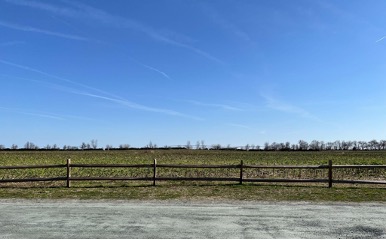
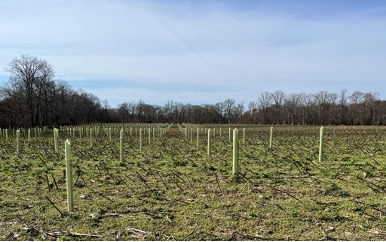
Pictured left: Before photo of a field planned to become meadow habitat for pollinators and songbirds. Pictured right: Trees were planted to expand the forested buffer for Edmonds Creek and the Cypress Branch of the Chester River.
Visit to learn more about the management plan for
Cypress Branch State Park and the wildlife that land managers hope to attract. The text on this sign is in both English and Spanish.
Location Details:
- Cypress Branch State Park
- 10803 Galena Rd, Millington, MD 21651
- Gravel/dirt, many parking spaces
- Sign located near parking area
- Portable toilet available at parking area
A landscape with many habitat types – often called a mosaic – supports biodiversity. Biodiversity is a key factor in climate resilience, as biodiverse communities are better able to adapt to changing conditions. For example, a disease affecting one species of tree in a forest won’t collapse the food web. Other trees and understory vegetation continue to produce food and serve as habitat. Hubs like Tuckahoe State Park, where there are large tracts of protected land, are a great opportunity to build resilient wildlife habitat.
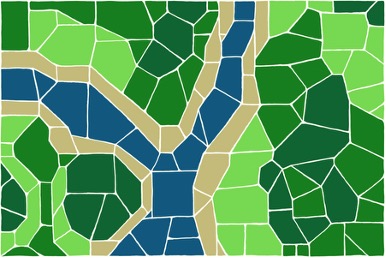
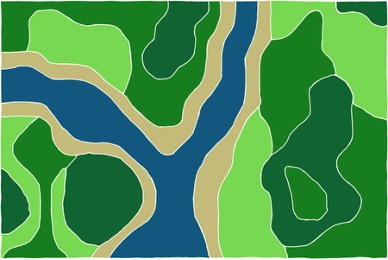
Pictured left: in art, a mosaic is an arrangement of small colored tiles. Pictured right: in natural resources management, a mosaic is the variation in habitat types across a landscape.
Visit
Tuckahoe State Park to learn more about biodiversity and the landscape mosaic.
Location Details:
- Tuckahoe State Park, Park Office & Ranger Station
- 12282 Eveland Rd, Ridgely, MD 21660
- Gravel/dirt, few parking spaces
- Sign located near parking entrance / trailhead
- Restrooms available at Park Office & Ranger Station
-
Trail map
When managing a forest to attract wildlife, it is important to consider how much food is available throughout the year. Three common plant-based food sources that land managers can work to support are mast, forbs, and legumes.
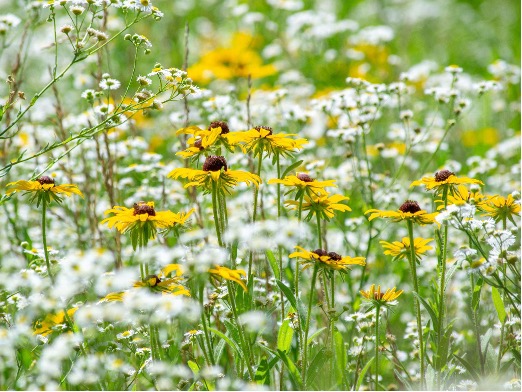
Pictured: Fleabane and black-eyed susan, our state flower, are examples of native forbs. Forbs provide food in many ways – leaves, nectar, seeds – and support a variety of wildlife including herbivores and pollinators.
Photo by Jordan Spause, 2023 Maryland DNR Photo Contest.
Visit
Idylwild Wildlife Management Area to learn more about each food type.
Location Details:
- Idylwild Wildlife Management Area
- 4404 Houston Branch Rd, Federalsburg, MD 21632
- Gravel/dirt, few parking spaces
- Sign located at parking area, near trailhead
-
Trail map
Timber harvesting is a broad term that encompasses a variety of harvest operations. Common operations include regeneration harvest, seed tree harvest, shelterwood harvest, selection harvest, pre-commercial thinning, and commercial thinning. Timber harvesting is just one of many ‘tools’ that forest managers can use to create habitat. Strong wood product markets – e.g. lumber, paper, pellets – are essential to utilizing this tool.
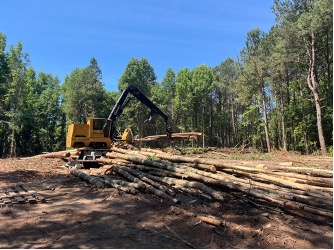
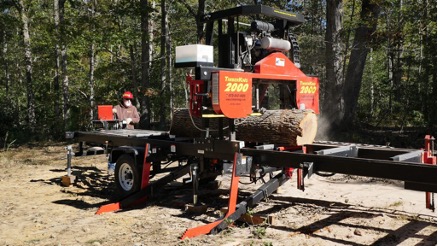
Pictured left: A loader with a merchandizing saw prepares downed timber to be delivered to a sawmill. Pictured right: Staff demonstrates using a portable sawmill.
Visit the
Chesapeake Forest Lands adjacent to
Idylwild Wildlife Management Area to learn about those six harvest operations and how timber harvesting can improve habitat for wildlife.
Location Details:
- Chesapeake Forest Lands, Messenger Branch Tract / Idylwild Wildlife Management Area
- Shared entrance with private residence, 4268 Houston Branch Rd, Federalsburg, MD 21632
- Dirt, limited parking spaces
- Sign located at parking area, near trailhead
-
Trail map
Land managers often need to cultivate multiple habitat structures for a target species. Northern bobwhite quail, for example, depend on both shrubby meadows and open mature woodlands. Dedicated management at Nanticoke River Wildlife Management Area (WMA) supports a strong quail population.
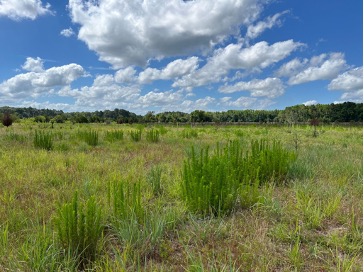
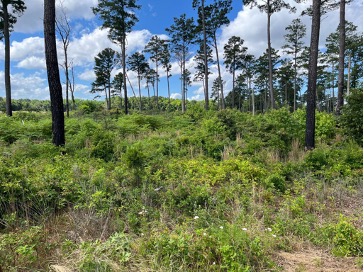
Pictured: Two types of habitat needed by northern bobwhite quail – shrubby meadow and open mature woodland – photographed at Nanticoke WMA.
Visit Nanticoke River WMA to learn more about this success story.
Location Details:
- Nanticoke River Wildlife Management Area
- Nutters Neck Rd, Hebron, MD 21830
- 2nd designated parking area [38°22'37.3"N 75°48'14.6"W]
- Gravel/dirt, few parking spaces
- Sign located on-trail, near parking area
-
Trail map
Forest management is often property-based. However, nature doesn’t recognize these mapped boundaries. When deciding on a management plan, it is important to consider the whole landscape. What ecosystem types exist nearby? How will the management on my land help build a balanced landscape?
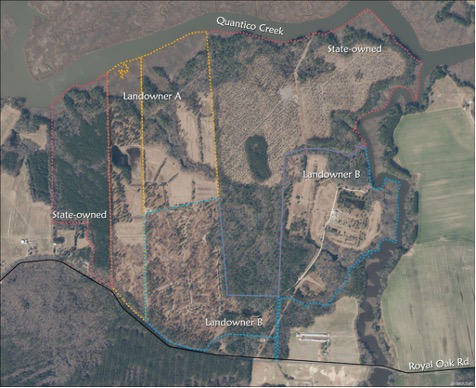
Pictured: a bird’s-eye view of this partnership, aimed at creating quality northern bobwhite quail habitat.
Visit the pull-off on Royal Oak Rd to learn more about the importance of partnerships.
Location Details:
- Private land
- Roadside pull-off [38°21'22.7"N 75°49'22.4"W]
- Dirt, limited spaces
The Eastern Shore of Maryland has more topography variation than most people give it credit for. From tidal marshes and bottomland cypress swamps up to inland sand ridges, the Shore has much to explore. Private forest management on the Eastern Shore was historically dominated by loblolly pine plantations. However, loblolly pines do not grow well in super sandy soils, such as on inland sand ridges. Forest managers use timber harvest and prescribed fire as the main tools to restore suitable native plant species in sandy areas.
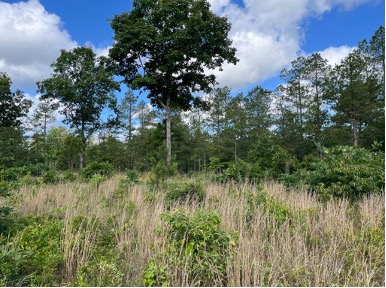
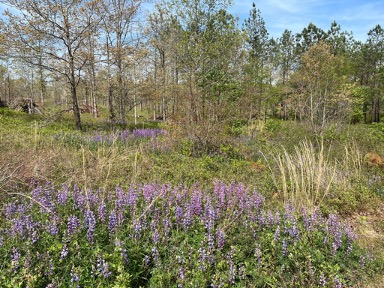
Pictured: Oak-pine savannas in the Pocomoke State Forest.
Visit the Pocomoke State Forest to learn more about oak-pine savanna habitat restoration.
Location Details:
- Pocomoke State Forest, Furnace Tract
- Parking available at the Furnace Town Historical Site, corner of Millville Rd and Old Furnace Rd
- Dirt, ample parking spaces
- Sign located on trail, not near parking area [38°12'18.2"N 75°28'33.8"W]
-
Trail map (PDF),
interactive trail map
Much like people, migratory birds need to rest and refuel along their journeys. Different birds depend on finding certain habitat types along the way. For example, some duck species prefer to stop in forested wetlands. A greentree reservoir is a special type of management unit – a purposefully flooded forest – that appeals to migratory waterfowl.
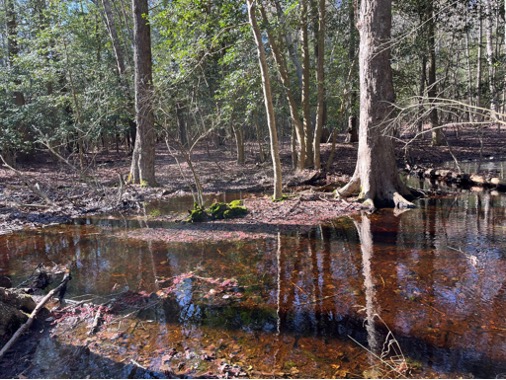
Pictured: A greentree reservoir at E. A. Vaughn WMA.
Visit
E. A. Vaughn Wildlife Management Area to learn more about how a greentree reservoir is managed.
Location Details:
- E. A. Vaughn Wildlife Management Area, North Tract
- 6416 Taylor Landing Rd, Girdletree, MD 21829
- Gravel/dirt, limited parking spaces
- Sign located at parking area
- North Tract
trail map, South Tract
trail map
Forest Management for Wildlife Habitat Fact Sheets
Explore how forest management practices can create, maintain, or restore wildlife habitat.
Faces of Forestry
The
Maryland Forests Association (MFA) introduces readers to industry professionals, land managers, and landowners leading the way in sustainable forest management. The articles related to the DWS program are linked below. Visit MFA’s
Faces of Forestry blog to learn more.
Additional Outcomes
Training Stewards & Landowners
University of Maryland Extension (Extension) built on their successful Maryland Woodland Stewards model to create a Delmarva Woodland Stewards course tailored to Delmarva’s unique landscape.
To date, almost 60 participants from Maryland, Delaware, and Virginia have learned about topics such as forest management best practices, riparian buffers, agroforestry, prescribed fire, vegetation management, and wood product markets. A daylong
field trip at the end of the course helps participants visualize what they’ve learned, including
coring a tree to learn its age. The course encourages participants to share this knowledge with family, friends, and neighbors, and integrate the concepts into the forest stewardship plan for their land.
Visit the
Maryland Woodland Stewards website for more information on courses for landowners.
Targeting High-Value Habitat Areas
The DWS program identified 3 target areas and 1 target species for in-depth map-based research.
The Pocomoke River, with its headwaters in Delaware’s Great Cypress Swamp and draining to the Chesapeake Bay, provides a corridor of swamp, marsh, and riparian forest habitats along its winding route.
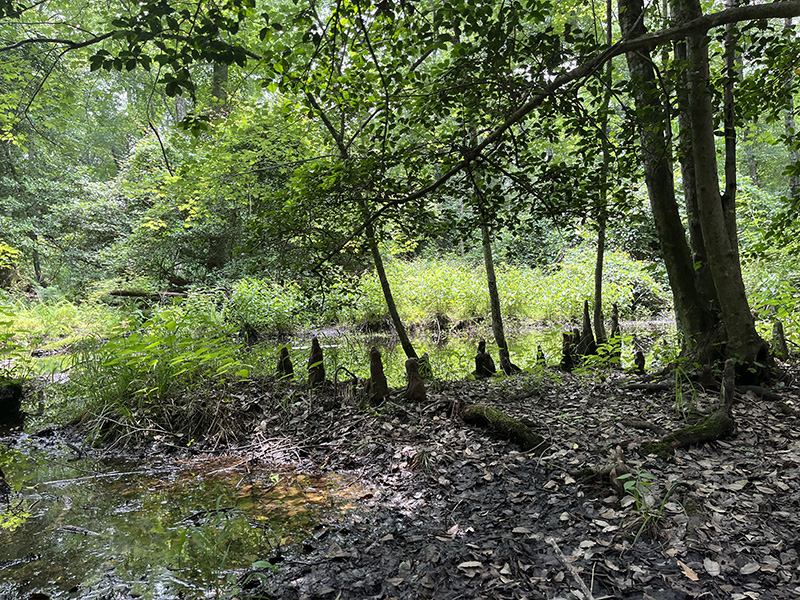
A cypress swamp
The river corridor (which also includes Nassawango Creek, Dividing Creek, and Pitts Creek in this analysis) is about 80% viable habitat; the watershed as a whole is about 60% viable habitat. These are strong numbers, however, both the river corridor and watershed habitats are fragmented by agricultural land, roadways, and developed areas. Habitat fragmentation is a major stressor to wildlife.
Refer to the Wildlife Habitat Connectivity poster to learn more about habitat in the Pocomoke River watershed and what can be done to improve connectivity.
Inland sand dunes (as well as ridges and flats) are a unique feature on Maryland’s Eastern Shore. The sand dunes best support early successional ecosystems that are disturbance-dependent and sunlight-loving. However, many of them are tucked away, hidden by forest cover. Though these forests do serve as habitat, restoration of the dunes would enhance the landscape and promote biodiversity. Research shows that the proportion of early successional habitat in Maryland is out of balance with older aged forests.
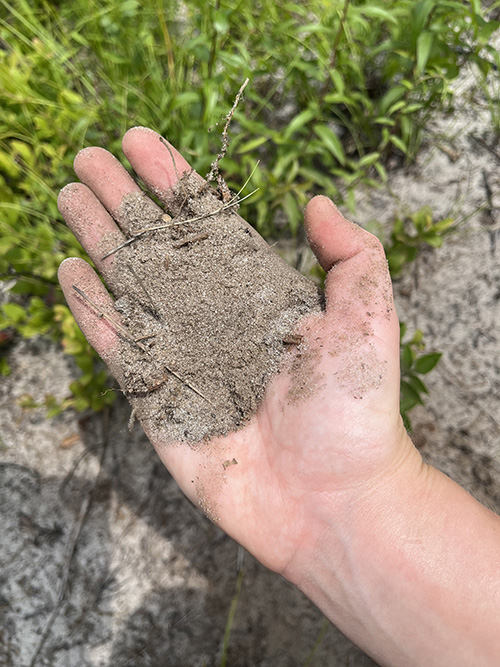
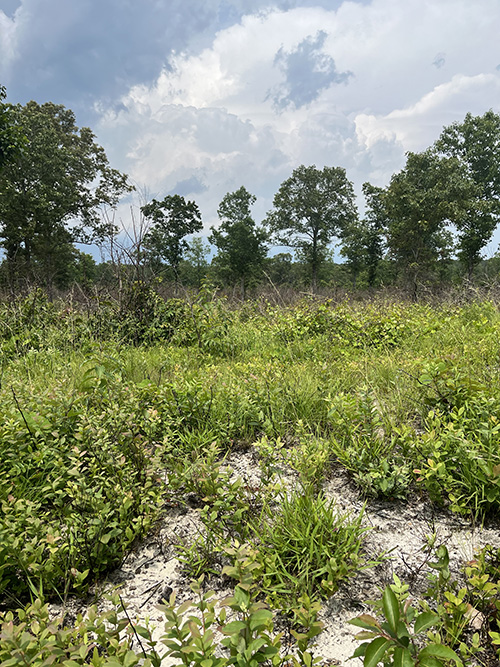
Sandy soil (pictured left) and an example of the habitat it supports (pictured right).
Refer to the Inland Sand Dune Identification poster to learn more about how these dunes were formed, how we identified them, and the type of habitat that they naturally support.
What’s the best way to get strong mussels? Plant trees!
A riparian buffer is the protective layer of forest or marsh on either side of a stream or river that helps slow run-off, cool the water, improve water quality, and reduce erosion. A good way to build a riparian buffer is to plant trees. At Browns Branch Wildlife Management Area, over 500 acres of trees have been planted to restore habitat and expand the riparian buffer. It is important to continue this effort throughout the watershed by engaging private landowners.
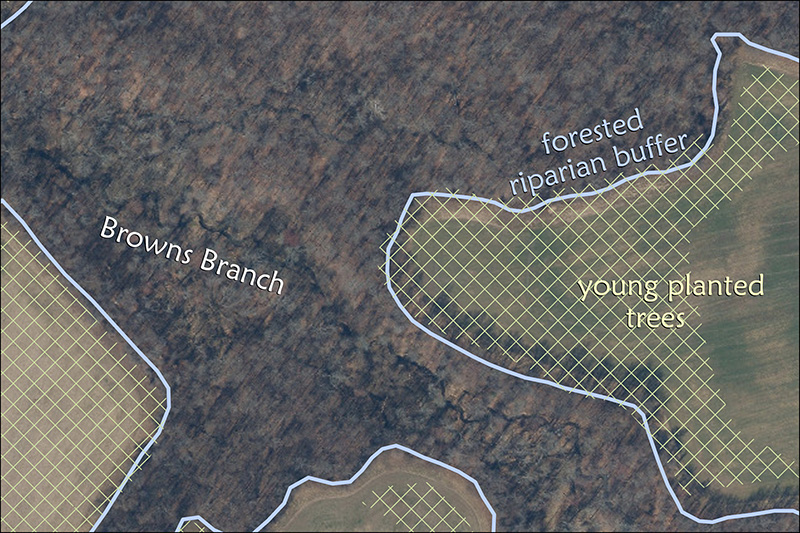
An example of a riparian buffer.
Browns Branch has high conservation priority due to freshwater mussel species richness. The upper reaches of the stream network are home to 8 documented species, including 4 that are rare, threatened, or endangered.
Refer to the Wildlife & Water Quality: Browns Branch poster to learn more about riparian buffers, freshwater mussels, and tree planting efforts.
This analysis is in progress. Check back in the fall for an update.
Restoring Fire to the Landscape
With help from
The Nature Conservancy (TNC), the DWS program supports safe, ecological prescribed burns that reduce wildfire risk and benefit native wildlife. Seasonal burn teams expanded capacity for local burning on the Delmarva peninsula, especially throughout TNC’s Nassawango Preserve.
The Delmarva Fire Ecology and Prescribed Fire Workshop - hosted on January 25, 2024 - was a highly successful event, reaching over 200 people in-person and online. The workshop brought in speakers from 8 partner agencies to cover a wide variety of fire-related topics. Unique presentations included finding evidence of historical fire in pollen records and fire’s effects on reptiles and amphibians.
Visit the
Land & Wildlife with Luke Macaulay channel to watch recordings of the presentations.
Formed in December, 2024, the Maryland Prescribed Fire Council (MPFC) aims to protect, promote, and expand the practice of prescribed burning throughout the state. MPFC will focus on expanding capacity for burning through education, outreach, policy, and partnerships.
Watch this recorded presentation,
Introduction to the Maryland Prescribed Fire Council, for more information, until a website is available.
Interest built and connections made during the Delmarva Fire Ecology and Prescribed Fire Workshop led to the formation of the Eastern Shore Prescribed Burn Association (ESPBA) in December, 2024. ESPBA is a collaboration between landowners and experts that aims to increase prescribed fire implementation on private land. Prescribed burns conducted by Maryland Forest Service are mostly on public land; in order to see a greater ecological impact on the landscape, engaging private landowners is key. ESPBA will foster resource sharing, networking, training, and experience-building across Cecil, Kent, Queen Anne’s, Caroline, Talbot, Dorchester, Wicomico, Somerset, and Worcester counties.
Watch this recorded presentation,
Introduction to the Eastern Shore Prescribed Burning Association, for more information, until a website is available.
Fill out
ESPBA’s interest form to join the mailing list.
Partners
Led by the Maryland Forest Service, this program is a collaboration between:
- University of Maryland Extension
- The Nature Conservancy, MD/DC Chapter
- Maryland Forests Association
- Maryland Forestry Foundation
- Local landowners and conservation partners
Contact Us
Whether you're a landowner, conservationist, or community member, there’s a place for you in the Delmarva Woodland Stewards network. Let’s work together for thriving wildlife, cleaner water, safer forests, and stronger rural economies.
Charly Sager
Delmarva Woodland Stewards Planner
Maryland Forest Service
Department of Natural Resources
201 Baptist Street, Suite 22
Salisbury, Maryland 21801
(443) 783-2000
[email protected]